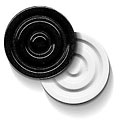|
Use of the special ability 1. When you succeed in pushing a loaded piece onto the middle spot on the board (i.e. the central intersection) you may make an extra move. Thus, the TAMSK-potential has the potential of an extra move. 2. When you push a Tamsk-potential on the central spot, take the potential from the basic piece and bring it back into play as a single piece: put it on a dot and push it onto a spot. Note: you may not leave the potential on top of the basic piece. If you don't make the extra move, you lose the potential; it goes out of the game. 3. If your opponent pushes one of your potentials onto the central spot, then, too, you get an extra move. In this case you must make the extra move before your regular move. Note: your opponent's turn must be completely finished before it is your turn again; if one or more rows must be captured, this must be done before you may make the extra move. 4. A regular move and an extra move are one turn, no matter whether the extra move is made before or after the regular move. The position of the pieces in between the two moves is regarded as an "interim" situation. This means that no pieces may be captured in between the making of a regular move and an extra move, by either player. (This also counts on the rare occasion that you succeed in pushing a second, or even third potential onto the central spot during one and the same turn). 5. The special ability of
a potential can be used only once. As a single piece ( i.e. after
you made an extra move with it) it has no more special power. This
implies that you may not leave it on the board when it is part of
a row that must be captured; it must be removed. The potential goes
out of the game, no matter whether it is you or your opponent who
takes it from the board. The TAMSK-potential can be used with or without connecting TAMSK to GIPF. If you play without TAMSK, you may use the special ability of the potential as described above, without further notice. First try it out at least a few times like that before you start combining games. |

